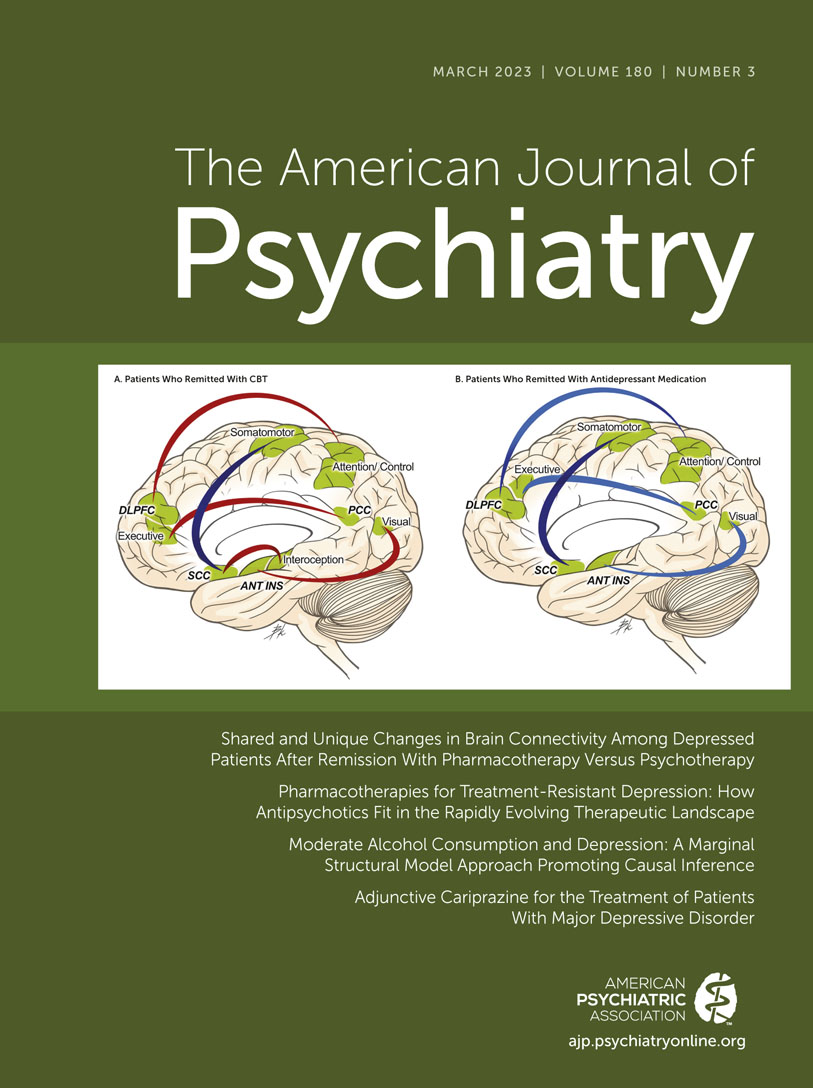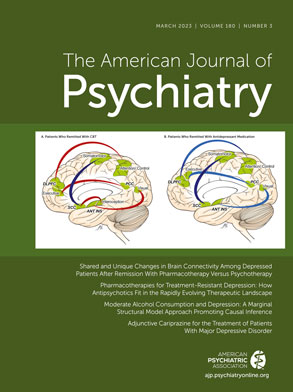The vision of biologically tailored treatment for mental illness has inspired clinical neuroscience since the days of Kraepelin and Alzheimer. In recent decades, large-scale initiatives ranging from the development and refinement of optogenetic technologies to the conception and application of the Human Connectome Project have expanded our background knowledge as we prepare to translate neuroimaging findings into clinical treatments. Although these approaches have not yet resulted in useful biomarkers in clinical practice, they are identifying potential new treatment targets (
1). In September 2022, the U.S. Food and Drug Administration cleared an fMRI-guided transcranial magnetic stimulation (TMS) protocol for major depression; this protocol is the first image-guided treatment in psychiatry. This approach appeared to be a promising improvement over our traditional approach to TMS targeting, which involves using a tape measure to take scalp measurements. While this advance was exciting for the field, it raised an important question: Is it time for psychiatrists to start using image guidance for clinical TMS?
This question has taken many forms since TMS was first cleared for treatment-resistant major depression in 2008. It is reasonable to ask whether the use of a tape measure over the scalp is the best way to target electromagnetic brain stimulation. Yet, attempts to find superior targeting methods have yielded mixed results. To improve targeting, a pilot clinical trial published in 2009 randomized 51 patients to receive clinical TMS with either structural MRI-based targeting or standard scalp-based targeting (
2). While the trial found some advantages to MRI-based targeting, it did not demonstrate significantly improved clinical outcomes. A more recently developed approach is to incorporate neuroscience-informed targeting. Over the past several years, negative resting-state functional connectivity between the TMS stimulation site and the subgenual anterior cingulate cortex (sgACC) has emerged as one of the most promising predictors of response to clinical TMS for depression and comorbid conditions (
3,
4). This relationship is consistent with the notion that the sgACC is overactive in major depression, leading some to speculate that sgACC activity might be suppressed by stimulating a site with activity that is negatively correlated with the sgACC (
3). At least two retrospective studies (N=24 and N=25) tested this hypothesis in patients who were incidentally stimulated at different locations due to variability in scalp-based targeting, which created a natural experiment to study the effect of targeting (
5,
6). In both studies, more effective stimulation sites were closer to the location of peak negative connectivity with the sgACC. These findings suggested that if individualized fMRI targeting had been implemented, clinical outcomes could have improved. Given the mixed findings, the field has remained uncertain about whether fMRI guidance should be used.
In this issue of the
Journal, Elbau et al. (
7) report on functional connectivity between the TMS stimulation site and the sgACC that shows incidental interindividual variability and creates another natural experiment that can be used to predict clinical outcomes. They used data from the largest published clinical trial of TMS, the THREE-D trial (
8); the original trial found that two different TMS protocols (10 Hz and theta burst TMS) for major depression were noninferior to each other. The THREE-D trial implemented structural neuronavigation, with the result that TMS was applied precisely and consistently to the same spot in all patients. Resting-state fMRI scans were obtained before treatment from 295 of the 395 patients in the THREE-D trial. In the present study, the investigators assessed whether functional connectivity could distinguish more effective stimulation sites from less effective sites.
The results appear encouraging for proponents of image-guided psychiatry. The most effective stimulation sites showed stronger functional anticorrelations with the sgACC, supporting a long-standing hypothesis about how to optimize TMS targeting (
9). These relationships were detectable only when using individualized biophysical models of how the electric field diffuses in the brain after penetrating the scalp, the skull, and the cerebrospinal fluid (
10). Thus, the effect was truly dependent on the specific parameters of the TMS target in each individual and not just a feature of the patient’s brain. This implies that individualized image-guided targeting would have improved clinical outcomes if it had been prospectively implemented in the original trial.
While this observation was promising, there were some crucial caveats. The observed effect of connectivity was weak, explaining only about 3% of the variance in clinical outcomes. This may be because the original study used a low-resolution MRI protocol that is now outdated; the same team that conducted the present study recently demonstrated that newer scan protocols are more reliable (
11). Perhaps even more problematic was the fact that the effects were heavily driven by patients with larger spontaneous signal fluctuations. The team attributed these fluctuations to a breathing pattern–induced artifact previously identified in young participants in the Human Connectome Project. This breathing pattern was reported to be more prevalent in males, is characterized by serial tapering of respiratory depth that occurs over several minutes, and may systematically induce artifacts in the fMRI signal. This explanation was supported by an analysis in which three experts evaluated these fMRI signal fluctuations and usually agreed that they could be explained by respiratory artifacts. Another interpretation is that large fluctuations may simply improve the ability to detect an effect in lower-resolution data, if the low-resolution MRI protocol was not sensitive to more subtle fluctuations.
The present study also has several important limitations. There was no sham group in the THREE-D trial, and the sgACC may also be involved in the placebo response (
12), although one would expect that the target specificity makes a placebo effect less likely to explain the primary results. It is also important to recognize that the imaging used in the study had low spatial resolution (5 mm in each dimension) and that the respiration-induced fMRI artifacts were assessed through consensus of the authors rather than a direct measure of respiration. The authors appropriately point out that imaging methods have substantially improved since the THREE-D trial was first designed, and newer approaches may yield better results. This particular study was designed to determine
whether image guidance independently adds value but not
how it should be done. Furthermore, it is unknown whether the male-biased breathing pattern identified in healthy young volunteers in the Human Connectome Project can be generalized to the older patients with major depression in the THREE-D trial. Finally, the THREE-D trial tested the independent effects of imaging only in the context of traditional daily treatment, which led to remission in less than 30% of patients over 6 weeks (
8). This rate of remission does not leave much room for predicting individual variability, especially since some of the improvement may have been attributable to a placebo effect.
Despite these caveats and limitations, this study helps us lay out a road map for the near-term studies needed to advance precision clinical brain stimulation. First among these is a prospective and rigorous comparison of image-guided TMS versus standard scalp-based targeting methods. This type of study would conclusively demonstrate whether targeting improves outcomes and quantify the added benefit of targeting when using newer, more reliable imaging protocols (
11). For those working in this space, it may also be valuable to directly measure respiration and evaluate the potential impact of respiratory artifacts in earlier image-guided TMS studies. Furthermore, it is unknown whether the same subgroup and respiratory effects will be obtained with different TMS protocols (e.g., higher-dose accelerated TMS [
13]). Last, the sgACC is one of many brain regions implicated in clinical TMS (
14). It may be that the fMRI signal in this region is particularly sensitive to artifacts, and one way forward would be to incorporate multiple brain regions into a network-level perspective.
Taken together, where does the study by Elbau et al. bring us? It reminds us that science is a dynamic and iterative process, and careful examination of the data yields evidence for optimism, skepticism, and ample opportunity to further develop image-guided TMS.

